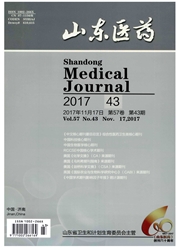

 中文摘要:
中文摘要:
目的研究影响重型颅脑损伤(TBI)患者预后的相关因素,建立简便、可靠、临床操作性强的TBI患者预后模型,提高重型颅脑损伤的治疗水平。方法回顾性分析236例重型TBI患者的临床资料。将脑疝、CT环池形态、患者年龄、GCS及手术方式作为观察指标,采用χ2检验及多因素Logistic回归分析。患者出院时进行预后分组,采用GCS分级标准,Ⅰ~Ⅱ级患者视为预后不良,Ⅲ~Ⅴ级患者视为预后良好。结果 236例重型TBI患者预后不良129例(54.66%),其中死亡81例(34.32%);预后良好107例(45.34%)。影响患者预后的因素依次为脑疝、CT环池形态、患者年龄、GCS。最优预后模型方程为In(P/1-P)=1.232×脑疝+1.176×环池形态+1.154×年龄-1.064×GCS+0.012。结论建立了重型TBI患者预后模型。脑疝、CT环池形态、患者年龄、GCS对重型TBI患者的预后有显著影响,尤其是存在脑疝及环池严重受压者预后不良几率增高。
 英文摘要:
英文摘要:
Objective To establish simple,reliable,clinical prognostic model of traumatic brain injury(TBI) and improve the treatment.Methods The hernia,CT central pool morphology,patient age,GCS and surgical methods were analyzed by using of χ2 test and multivariate Logistic regression analysis in retrospective analysis of 236 cases of severe TBI patients with clinical data.According GCS,the cases of Ⅰ~Ⅱ grade were divided into poor prognosis one,Ⅲ~Ⅴ grade into good prognosis one.Results In 236 cases of severe TBI patients,There were 129 cases(54.66%) of poor prognosis,81 cases(34.32%)died;107 cases(45.34%) of good prognosis.Prognostic factors were brain herniation,CT central pool morphology,patient age,GCS.The best prognostic model equation was In(P/1-P)=1.232×hernia ring cell morphology+1.176×age+1.154×-1.064×GCS+0.012.Conclusions A prognostic model for severe TBI is succesfully established.Herniation,CT central pool morphology,patient age and GCS are significantly factors effect on the prognosis of patients with severe TBI,especially if there is herniation and severe compression central pool,the risk of poor prognosis is increased.
 同期刊论文项目
同期刊论文项目
 同项目期刊论文
同项目期刊论文
 期刊信息
期刊信息
